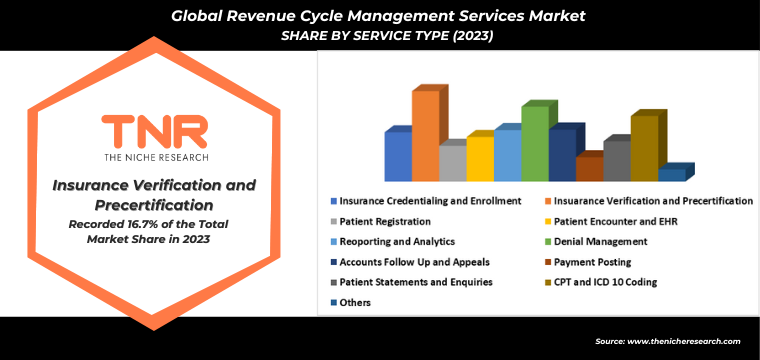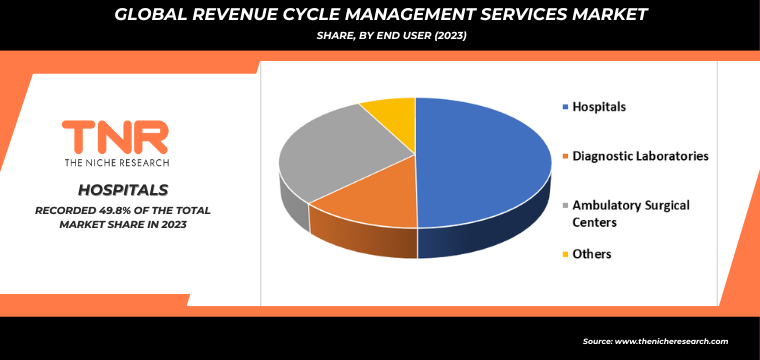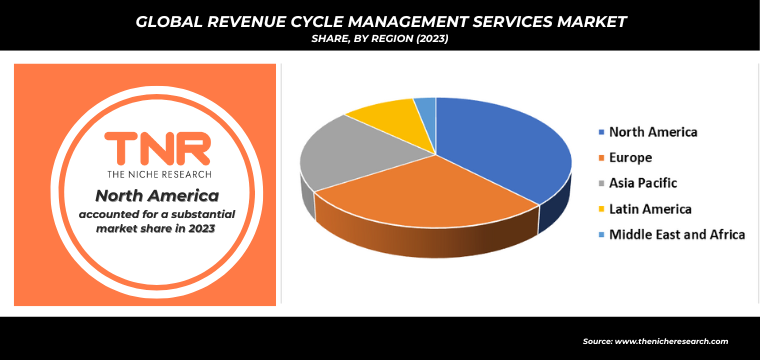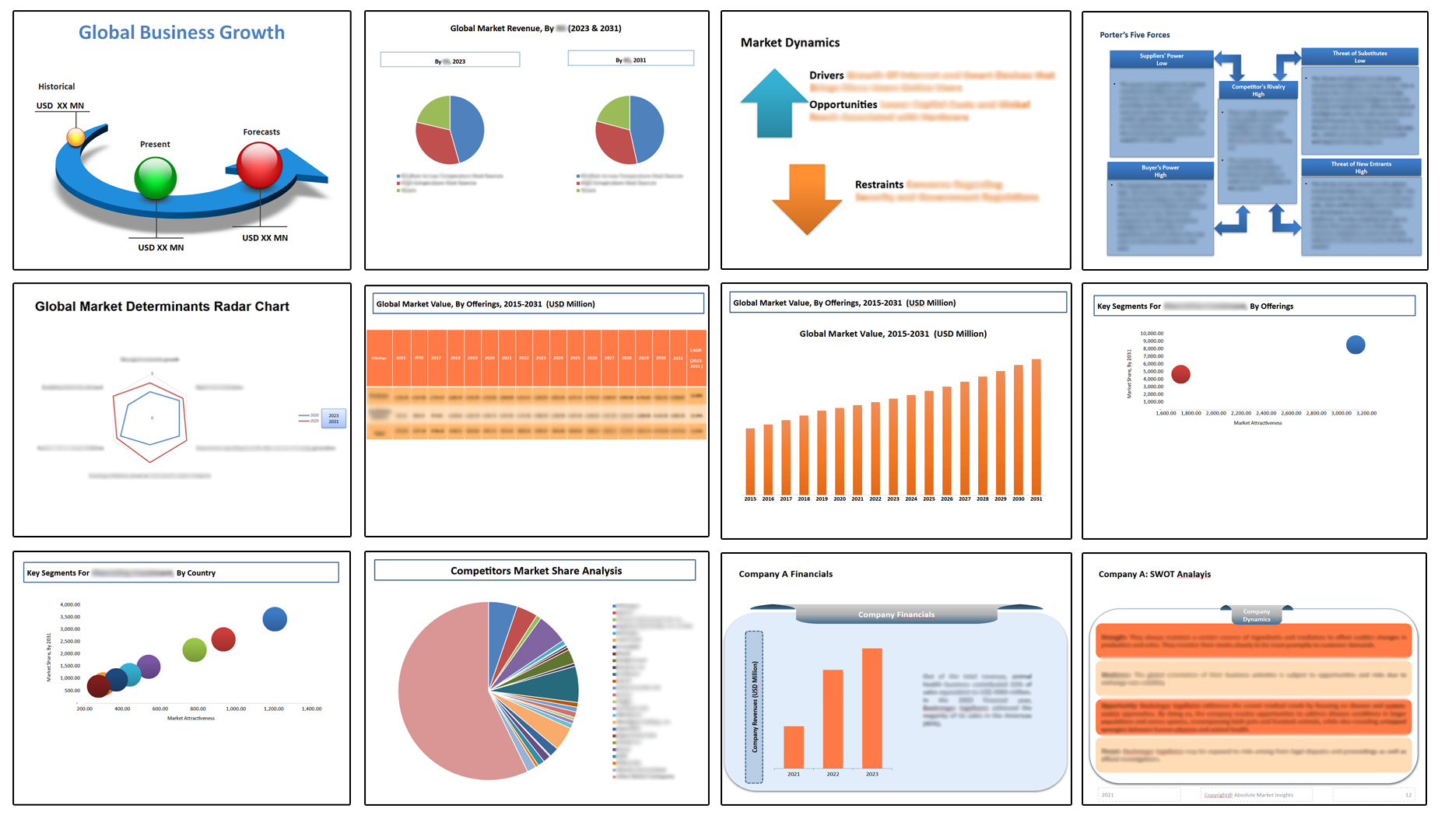Global Revenue Cycle Management Services Market, By Service Type, By End User, By Region & Segmental Insights Trends and Forecast, 2024 – 2034
- Industry: Healthcare
- Report ID: TNR-110-1172
- Number of Pages: 420
- Table/Charts : Yes
- June, 2024
- Base Year : 2024
- No. of Companies : 10+
- No. of Countries : 29
- Views : 10100
- Covid Impact Covered: Yes
- War Impact Covered: Yes
- Formats : PDF, Excel, PPT
In Terms of Revenue, the Global Revenue Cycle Management Services Market was Worth US$ 253.5 Bn in 2023 and is Anticipated to Witness a CAGR of 9.6% During 2024 – 2034.
Revenue Cycle Management (RCM) Services encompass the financial processes healthcare providers use to track patient care episodes from registration and appointment scheduling to the final payment of a balance. The global revenue cycle management services market is witnessing significant growth driven by the increasing complexity of healthcare reimbursement systems, the rising demand for healthcare services, and the shift towards value-based care. Key growth drivers include the growing adoption of electronic health records (EHRs) and the need to manage large volumes of patient data efficiently. Additionally, stringent regulatory requirements and the rising need to reduce billing errors and operational costs are propelling market growth.
Current trends in the market involve the integration of advanced technologies such as Artificial Intelligence (AI) and Machine Learning (ML) to streamline RCM processes, enhancing accuracy and speed. The outsourcing of RCM services is also gaining traction as healthcare providers seek to focus more on core clinical activities. Opportunities abound in developing regions where healthcare infrastructure is rapidly evolving, and in the expansion of RCM services to smaller healthcare facilities and practices. The market is poised for robust growth as these services become indispensable for maintaining the financial health of healthcare organizations globally.

Revenue Cycle Management Services Market Dynamic
Growth Driver-
Increasing Adoption of Electronic Health Records (EHRs) Across Healthcare Systems
The transition from paper-based records to digital EHRs has created a need for sophisticated RCM solutions that can efficiently handle large volumes of data, streamline billing processes, and ensure compliance with evolving healthcare regulations. EHRs facilitate better coordination between healthcare providers and payers, reducing errors and improving the accuracy of claims. As healthcare organizations strive for greater operational efficiency and cost reduction, the integration of EHRs with RCM systems becomes crucial. This trend is driving the demand for comprehensive RCM services that can optimize revenue cycles, enhance patient satisfaction, and ultimately improve financial performance.
Trends-
Integration of Artificial Intelligence (AI) and Machine Learning (ML) Technologies
These advanced technologies are revolutionizing RCM processes by automating routine tasks, predicting payment patterns, and identifying potential claim denials before they occur. AI and ML enhance data accuracy and processing speed, which significantly reduces human error and operational costs. Moreover, these technologies enable predictive analytics, offering insights that help healthcare providers optimize their revenue cycles and improve decision-making. By adopting AI and ML, healthcare organizations can streamline billing, accelerate payment collections, and enhance overall financial performance. This trend is driving substantial investments in AI-powered RCM solutions, underscoring their growing importance in the healthcare sector.
Challenge-
Complexity of Regulatory Compliance
Healthcare providers must navigate an intricate web of federal, state, and local regulations, which are continually evolving. Staying compliant requires significant effort and resources, as any misstep can lead to substantial financial penalties and damage to the organization’s reputation. This complexity is further compounded by frequent changes in healthcare policies, insurance requirements, and reimbursement rules. For instance, the shift from fee-for-service to value-based care models introduces new compliance standards and documentation requirements. As a result, healthcare organizations must invest in continuous education and advanced RCM solutions to keep up with regulatory changes, posing a considerable challenge in maintaining efficient and compliant revenue cycle operations.
Revenue Cycle Management Services Market Segmentation by Service Type, End User, Region
Insurance verification and precertification segment by service type is set to dominate the revenue cycle management services market, commanding a substantial revenue share of 16.7% over the forecast period.
Increasing complexity of insurance policies and coverage requirements necessitates thorough verification processes to ensure claims are accurately processed and reimbursed. The rise in patient volume and the expansion of healthcare services drive demand for efficient RCM services to manage administrative tasks, reduce claim denials, and enhance cash flow. Thirdly, regulatory changes and the shift towards value-based care models require precise documentation and verification to meet compliance standards. Technological advancements in RCM software and automation tools have improved the efficiency and accuracy of insurance verification and precertification processes, making them more cost-effective and attractive for healthcare providers. These factors collectively contribute to the segment’s substantial revenue share and its critical role in optimizing healthcare financial operations.

Ambulatory Surgical Centers by end user is anticipated to be the fastest-growing segment in the revenue cycle management services market, capturing a substantial revenue share of 29.6% over the forecast period.
Increasing shift towards outpatient care is driving more procedures to be performed in ASCs, which offer cost-effective and convenient alternatives to hospital-based surgeries. ASCs face unique RCM challenges, including complex billing and coding requirements for a wide variety of surgical procedures, necessitating specialized RCM services to ensure accurate and timely reimbursement. Thirdly, the rise in patient volume at ASCs amplifies the need for efficient RCM processes to handle billing, insurance verification, and claim management effectively. Advancements in medical technology and surgical techniques continue to expand the range of services offered by ASCs, further boosting their growth and the demand for robust RCM solutions to optimize financial performance and ensure regulatory compliance.

In 2023, North America is anticipated to play a significant role in propelling the growth of the revenue cycle management services market, contributing approximately 37.1% to its overall expansion.
The region boasts a well-established healthcare infrastructure with a high adoption rate of advanced technologies and RCM solutions. The complex regulatory environment in North America, including evolving healthcare policies and compliance requirements, drives demand for specialized RCM services to ensure adherence and optimize financial operations. Prevalence of private healthcare insurance and robust reimbursement systems incentivizes healthcare providers to invest in efficient RCM processes to streamline billing, coding, and claims management.
Moreover, the region’s proactive approach towards healthcare digitization and data analytics further enhances the effectiveness and efficiency of RCM services, supporting revenue growth. Overall, North America’s mature healthcare system, coupled with its technological advancements and regulatory dynamics, positions it as a key driver in the expansion of the RCM services market.

Major Players in Revenue Cycle Management Services Market
- AdvancedMD
- Athenahealth
- CureMD Healthcare
- Guidehouse
- Passage Health International, L.L.C.
- PwC
- Transcure
- TrueCare RCM
- Vee Healthtek
- Veradigm LLC (AllScripts Healthcare, LLC)
- Virtual Healthcare
- Vitality
- Other Industry Participants
Global Revenue Cycle Management Services Market Scope
| Report Specifications | Details |
| Market Revenue in 2023 | US$ 253.5 Bn |
| Market Size Forecast by 2034 | US$ 694.7 Bn |
| Growth Rate (CAGR) | 9.6% |
| Historic Data | 2016 – 2022 |
| Base Year for Estimation | 2023 |
| Forecast Period | 2024 – 2034 |
| Report Inclusions | Market Size & Estimates, Market Dynamics, Competitive Scenario, Trends, Growth Factors, Market Determinants, Key Investment Segmentation, Product/Service/Solutions Benchmarking |
| Segments Covered | By Service Type, By End User, By Region |
| Regions Covered | North America, Europe, Asia Pacific, Middle East & Africa, Latin America |
| Countries Covered | U.S., Canada, Mexico, Rest of North America, France, The UK, Spain, Germany, Italy, Nordic Countries (Denmark, Finland, Iceland, Sweden, Norway), Benelux Union (Belgium, The Netherlands, Luxembourg), Rest of Europe, China, Japan, India, New Zealand, Australia, South Korea, Southeast Asia (Indonesia, Thailand, Malaysia, Singapore, Rest of Southeast Asia), Rest of Asia Pacific, Saudi Arabia, UAE, Egypt, Kuwait, South Africa, Rest of Middle East & Africa, Brazil, Argentina, Rest of Latin America |
| Key Players | AdvancedMD , Athenahealth, CureMD Healthcare, Guidehouse, Passage Health International, L.L.C. , PwC, Transcure, TrueCare RCM, Vee Healthtek, Veradigm LLC (AllScripts Healthcare, LLC), Virtual Healthcare, Vitality |
| Customization Scope | Customization allows for the inclusion/modification of content pertaining to geographical regions, countries, and specific market segments. |
| Pricing & Procurement Options | Explore purchase options tailored to your specific research requirements |
| Contact Details | Consult With Our Expert
Japan (Toll-Free): +81 663-386-8111 South Korea (Toll-Free): +82-808- 703-126 Saudi Arabia (Toll-Free): +966 800-850-1643 United Kingdom: +44 753-710-5080 United States: +1 302-232-5106 E-mail: askanexpert@thenicheresearch.com
|
Global Revenue Cycle Management Services Market
By Service Type
- Insurance Credentialing and Enrollment
- Insurance Verification and Precertification
- Patient Registration
- Patient Encounter and EHR
- Reporting and Analytics
- Denial Management
- Accounts Follow Up and Appeals
- Payment Posting
- Patient Statements and Enquiries
- CPT and ICD 10 Coding
- Others
By End User
- Hospitals
- Diagnostic Laboratories
- Ambulatory Surgical Centers
- Others
By Region
- North America (U.S., Canada, Mexico, Rest of North America)
- Europe (France, The UK, Spain, Germany, Italy, Nordic Countries (Denmark, Finland, Iceland, Sweden, Norway), Benelux Union (Belgium, The Netherlands, Luxembourg), Rest of Europe)
- Asia Pacific (China, Japan, India, New Zealand, Australia, South Korea, Southeast Asia (Indonesia, Thailand, Malaysia, Singapore, Rest of Southeast Asia), Rest of Asia Pacific)
- Middle East & Africa (Saudi Arabia, UAE, Egypt, Kuwait, South Africa, Rest of Middle East & Africa)
- Latin America (Brazil, Argentina, Rest of Latin America)
Report Layout:

Table of Contents
Note: This ToC is tentative and can be changed according to the research study conducted during the course of report completion.
**Exclusive for Multi-User and Enterprise User.
Global Revenue Cycle Management Services Market
By Service Type
- Insurance Credentialing and Enrollment
- Insurance Verification and Precertification
- Patient Registration
- Patient Encounter and EHR
- Reporting and Analytics
- Denial Management
- Accounts Follow Up and Appeals
- Payment Posting
- Patient Statements and Enquiries
- CPT and ICD 10 Coding
- Others
By End User
- Hospitals
- Diagnostic Laboratories
- Ambulatory Surgical Centers
- Others
By Region
- North America (U.S., Canada, Mexico, Rest of North America)
- Europe (France, The UK, Spain, Germany, Italy, Nordic Countries (Denmark, Finland, Iceland, Sweden, Norway), Benelux Union (Belgium, The Netherlands, Luxembourg), Rest of Europe)
- Asia Pacific (China, Japan, India, New Zealand, Australia, South Korea, Southeast Asia (Indonesia, Thailand, Malaysia, Singapore, Rest of Southeast Asia), Rest of Asia Pacific)
- Middle East & Africa (Saudi Arabia, UAE, Egypt, Kuwait, South Africa, Rest of Middle East & Africa)
- Latin America (Brazil, Argentina, Rest of Latin America)
The Niche Research approach encompasses both primary and secondary research methods to provide comprehensive insights. While primary research is the cornerstone of our studies, we also incorporate secondary research sources such as company annual reports, premium industry databases, press releases, industry journals, and white papers.
Within our primary research, we actively engage with various industry stakeholders, conducting paid interviews and surveys. Our meticulous analysis extends to every market participant in major countries, allowing us to thoroughly examine their portfolios, calculate market shares, and segment revenues.
Our data collection primarily focuses on individual countries within our research scope, enabling us to estimate regional market sizes. Typically, we employ a bottom-up approach, meticulously tracking trends in different countries. We analyze growth drivers, constraints, technological innovations, and opportunities for each country, ultimately arriving at regional figures.Our process begins by examining the growth prospects of each country. Building upon these insights, we project growth and trends for the entire region. Finally, we utilize our proprietary model to refine estimations and forecasts.
Our data validation standards are integral to ensuring the reliability and accuracy of our research findings. Here’s a breakdown of our data validation processes and the stakeholders we engage with during our primary research:
- Supply Side Analysis: We initiate a supply side analysis by directly contacting market participants, through telephonic interviews and questionnaires containing both open-ended and close-ended questions. We gather information on their portfolios, segment revenues, developments, and growth strategies.
- Demand Side Analysis: To gain insights into adoption trends and consumer preferences, we reach out to target customers and users (non-vendors). This information forms a vital part of the qualitative analysis section of our reports, covering market dynamics, adoption trends, consumer behavior, spending patterns, and other related aspects.
- Consultant Insights: We tap into the expertise of our partner consultants from around the world to obtain their unique viewpoints and perspectives. Their insights contribute to a well-rounded understanding of the markets under investigation.
- In-House Validation: To ensure data accuracy and reliability, we conduct cross-validation of data points and information through our in-house team of consultants and utilize advanced data modeling tools for thorough verification.
The forecasts we provide are based on a comprehensive assessment of various factors, including:
- Market Trends and Past Performance (Last Five Years): We accurately analyze market trends and performance data from preceding five years to identify historical patterns and understand the market’s evolution.
- Historical Performance and Growth of Market Participants: We assess the historical performance and growth trajectories of key market participants. This analysis provides insights into the competitive landscape and individual company strategies.
- Market Determinants Impact Analysis (Next Eight Years): We conduct a rigorous analysis of the factors that are projected to influence the market over the next eight years. This includes assessing both internal and external determinants that can shape market dynamics.
- Drivers and Challenges for the Forecast Period:Identify the factors expected to drive market growth during the forecast period, as well as the challenges that the industry may face. This analysis aids in deriving an accurate growth rate projection.
- New Acquisitions, Collaborations, or Partnerships: We keep a close watch on any new acquisitions, collaborations, or partnerships within the industry. These developments can have a significant impact on market dynamics and competitiveness.
- Macro and Micro Factors Analysis:A thorough examination of both macro-level factors (e.g., economic trends, regulatory changes) and micro-level factors (e.g., technological advancements, consumer preferences) that may influence the market during the forecast period.
- End-User Sentiment Analysis: To understand the market from the end-user perspective, we conduct sentiment analysis. This involves assessing the sentiment, preferences, and feedback of the end-users, which can provide valuable insights into market trends.
- Perspective of Primary Participants: Insights gathered directly from primary research participants play a crucial role in shaping our forecasts. Their perspectives and experiences provide valuable qualitative data.
- Year-on-Year Growth Trend: We utilize a year-on-year growth trend based on historical market growth and expected future trends. This helps in formulating our growth projections, aligning them with the market’s historical performance.
Research process adopted by TNR involves multiple stages, including data collection, validation, quality checks, and presentation. It’s crucial that the data and information we provide add value to your existing market understanding and expertise. We have also established partnerships with business consulting, research, and survey organizations across regions and globally to collaborate on regional analysis and data validation, ensuring the highest level of accuracy and reliability in our reports.









